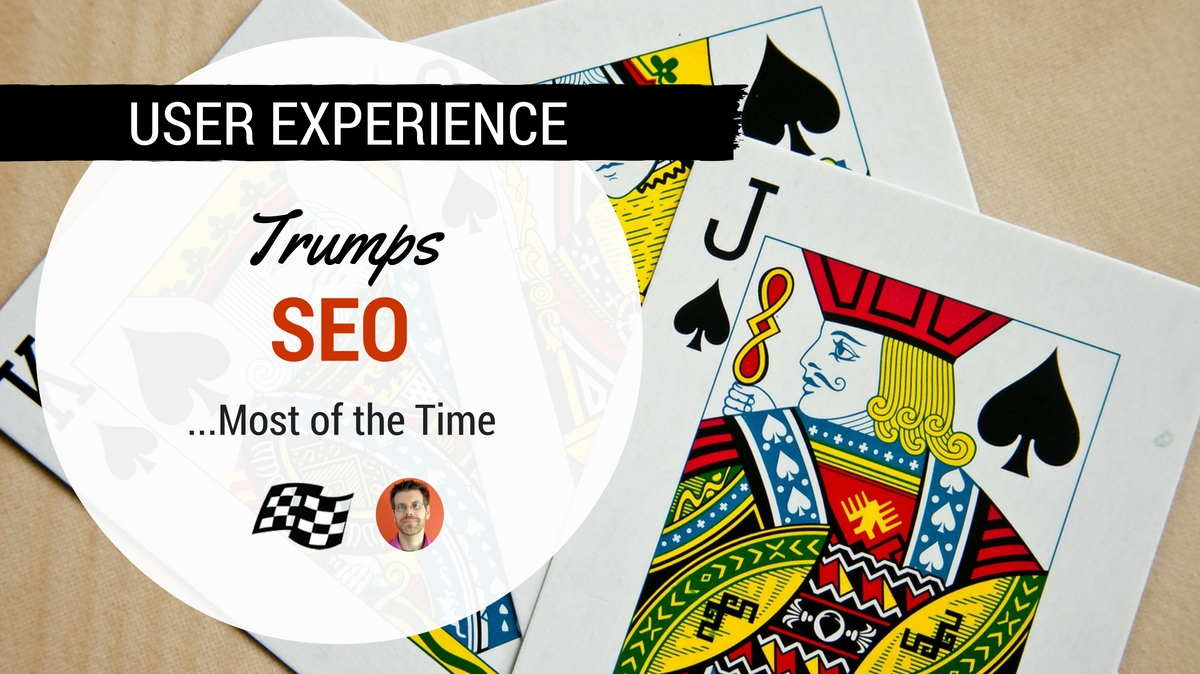
I recently had the opportunity to share my thoughts on SEO and user experience in a Facebook Live session on Search Engine Journal‘s Facebook page. The Facebook Live session was to promote SEJ’s The Beginner’s Guide to SEO 2016 for which I contributed a chapter on SEO and user experience.
Below are the questions I answered on Facebook Live. Don’t want to read? Check out the video!
How do you find a perfect balance between user experience and SEO?
I don’t know that there is any such thing as a perfect balance. For the most part, what is good for visitors is also good for search engines. But there are things that you have to do for search engines that visitors are completely agnostic toward. If you focus on the visitor first, you’ll be 90% of the way to having what you need. However, if there is ever a conflict between what is good for people vs. search engines, you’re probably better off focusing on the user.
What SEO and UX best practices do you suggest?
My book, The Best Damn Web Marketing Checklist, Period! lays out a series of best practices that covers virtually every aspect of online marketing. The book covers both user experience and search engine recommendations. That’s my first place to start. One tip that I really like to focus on is title tags. This is one of those places that packs a huge punch for both search and usability. A good title tag will move you up in search engine rankings and generate quality clicks to your website.
Why do you give much emphasis on keyword research?
Keyword research is really audience research. It gives you insight into exactly how people think about the products or services you offer, what terminology they use, what their needs are, and the solutions they are looking for. This forms the entire foundation of digital marketing.
What SEO and UX principles do you roll out at Pole Position Marketing?
The visitor comes first. There are a lot of marketers out there gaming the system and, unfortunately, they still get results. We have always steered our clients away from these practices because we know they are short term gains that, in the long run, will likely hurt them. It’s not always easy to do that, but we are in the business of making other businesses better for their customers.
You mentioned that clicks are important, but how do you ensure conversion?
You can never ensure conversions, but what you can do is make sure that when a searcher clicks to your site you are addressing their specific need. The question to answer is, “What does the searcher expect to find when they click a link from the search results?” If you can answer that question, you have vastly improved your chances of getting a conversion. There are more steps to it after that, but that’s the big first step.
What calls to action tactics do you suggest?
Again, this goes back to meeting the searcher’s expectations. If you know what they want to find, you can make sure your content provides that. The call to action is nothing more than a guide to the next step in the process. But calls to action are not one-size-fits-all. It’s more of a choose your own adventure. Your job is to provide the calls to action that will keep different visitors engaged on their conversion journey.
What challenges should we expect in making sure that SEO and UX work together?
I think it’s always a challenge to stay focused on the visitor. It’s so easy to use search engine rankings as a metric for success. Rankings are a means to an end, but not the end itself. And there are times that what works great for search engines isn’t so good for the visitor. In those situations, when you opt to do what the search engines “want,” you may get the rankings and clicks, but you’ll suffer in other ways.
How should we overcome these challenges?
At the risk of sounding like a broken record, default to the user experience over search. If—and only if—your overall results are worse, reverse course.
Aside from SEO and UX, is the design interface just as important?
I think the design interface of a website plays a substantial role in user experience. In fact, everything on your site factors into UX. There is almost nothing you can do that doesn’t impact it in some way.
 “Everything on your site factors into UX. There is almost nothing you can do that doesn’t impact it in some way.”
“Everything on your site factors into UX. There is almost nothing you can do that doesn’t impact it in some way.”
In what instances should we be willing to let SEO or UX suffer?
Only when the data tells you to. Every change you make should be monitored in Analytics. Some SEO-focused changes can bring in a lot more clicks, but lower your conversion rate. If the net result is more sales, then it’s probably worth having a slightly less user-focuses website. In fact, I’m convinced many of the big-data companies (Netflix, Google, etc.) sacrifice user experience all the time if they see that it puts more profits in their pocket. That’s not necessarily wrong. Ultimately, that is their job. But this approach has to be done with caution. Too much of it and you’ll hit a tipping point and lose goodwill and see your market share plummet before you can correct it.
